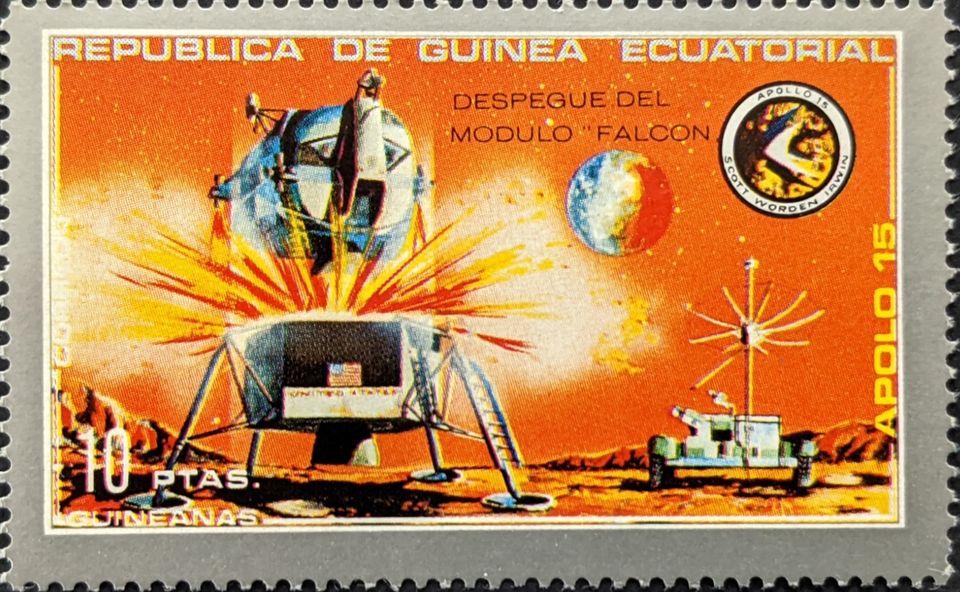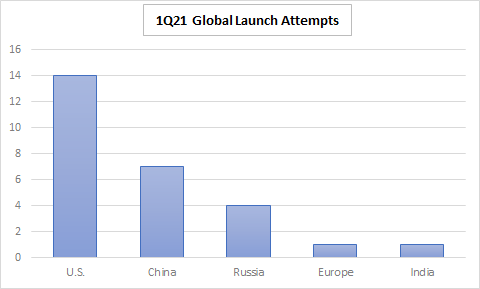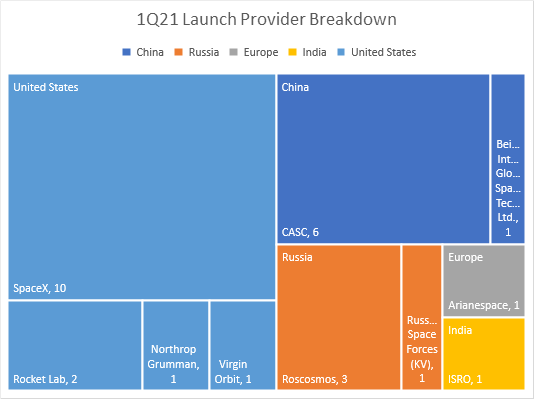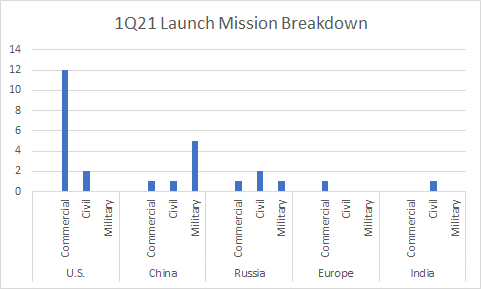1Q21 Orbital Space Launch Review

A minor launch update for 2021. The upshot: a particular company (with a name that rhymes with “base specs”) has been very busy.
1Q21 Launch Attempts
Rocket launch services worldwide have attempted 27 launches so far (including yesterday’s Falcon 9 launch). That’s 24% of 2020’s total launch attempts. Of 2021’s attempts, one failed (a rocket from China). The launch attempt breakdown of the first quarter 2021 (data from Gunter’s Space Page) looks like this:

Japan’s launch service providers have yet to launch in 2021. For the Europeans, the single launch was conducted from Russia to fulfill Arianespace’s OneWeb obligations. Europe’s very own launch location, Kourou (in French Guiana), has yet to conduct 2021 launches using Vega, Ariane 5, or the Soyuz.
Considering all the hype surrounding how much China and Russia are ahead of the U.S. in space, the above chart might be surprising to those buying into that narrative. U.S. launches are double that of China’s (including a failure in China) and more than triple Russia’s launch activities. Of course, three quarters are remaining in the year, so maybe they’ll catch up.
1Q21 Launch Providers
The launch providers within each nation break down like so:

Unsurprisingly, considering SpaceX’s Starlink launches, the company contributed over one-third of the world’s launches so far with 10. SpaceX’s launches increased 67% this year when compared with the six conducted launches by this time last year. SpaceX is two launches shy of half of its total 2020 launches. Rocket Lab is also up from its single launch during 1Q20 to two launches for 2Q21.
Of the U.S. companies, the United Launch Alliance (ULA) hasn’t conducted any launches in 2021 so far. In 2020, ULA had already conducted two launches by 1Q20’s end. Also notable for the U.S. is that Virgin Orbit finally successfully launched a LauncherOne rocket. Considering how much business the company has said it’s received, it’s a little surprising three months have passed since its January launch with no other launch.
China’s China Aerospace Science and Technology Corporation (CASC) continues launching versions of its CZ-3 and CZ-4 rockets. It launched those rockets’ successor, the CZ-7, during the first quarter (the second launch of the CZ-7 overall). All CASC launches were successful. China’s single unsuccessful launch was the second attempted launch of a Hyperbola rocket by the Beijing Interstellar Glory Space Technology Ltd.
Russian activities are slightly ahead of the nation’s 2020 launches for the quarter.
Europe’s Arianespace launch activities for 1Q21 are down from 2020 so far. In 2020, the company had conducted four launches (2 from Kazakhstan and two from Kourou).
1Q21 Mission Breakdown
I’ve broken down the types of missions driving these launches into three categories (very simply defined):
- Commercial: launches of satellites with a commercial purpose (profit is the priority)
- Civil: launches of satellites with a civil purpose (government-provided public services)
- Military: launches of satellites supporting/augmenting a government’s military
For launches deploying multiple satellites, the assumption is the satellite with the most mass is likely the primary driver for the launch. The assumption means I’m relying on my judgment to determine which satellites may be the primary reason for a launch.

In total, 15 launches (56% of 27 launches) were conducted for commercial reasons. Twelve of those were conducted by U.S. launch service providers. Eight of the 12 commercial U.S. launches were dedicated to Starlink satellite deployments. Of the six military-focused launches, China launched five.
The takeaway from the first quarter is that SpaceX can and is launching rockets at a pace no one has seen before. It’s managed to increase how often it can launch rockets by 67% (compared with 2020, so far), averaging about three Falcon 9 launches per month. If the company continues with that pace for the remainder of the year, it will have launched at least 37 times for 2021--about six launches shy of the U.S. 2020 total.
The lack of Arianespace and ULA launches during the first quarter of 2021 can’t be attributed to SpaceX’s launch rate. The majority of satellites SpaceX has deployed during the first quarter aren’t what those companies typically launch. Of all of SpaceX’s launches in 2021 so far, only one--Türksat 5A--would have been a possible customer for Arianespace. ULA has made it clear its primary goal is pursuing government contracts.
It could be the lack of launches from those companies is a result of the pandemic.
Expect more related analysis in the next update.




Comments ()